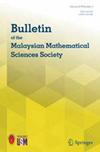$$K_{1,2}$$ -无爪立方图的隔离数
IF 1.2
3区 数学
Q1 MATHEMATICS
Bulletin of the Malaysian Mathematical Sciences Society
Pub Date : 2024-03-14
DOI:10.1007/s40840-024-01672-w
引用次数: 0
摘要
让 G 是一个图,\({\mathcal {F}}\)是一个连通图族。如果 \(G-N[S]\) 不包含 \({\mathcal {F}}\) 中的任何子图,那么 G 的子集 S 称为 \({\mathcal {F}}\)-isisolating 集、图 G 的隔离集的最小卡片数称为图 G 的隔离数,用 \(\iota (G,{\mathcal {F}})\ 表示。为简单起见,让 \(\iota (G,\{K_{1,k+1}\})=\iota _k(G)\)。因此,\(\iota _1(G)\)是一个最小集合S的卡片数,使得\(G-N[S]\)只包含\(K_1\)和\(K_2\)。在本文中,我们证明了对于任何阶数为 n 的无爪立方图 G,\(\iota _1(G)\le \frac{n}{4}\)。这个约束是尖锐的。本文章由计算机程序翻译,如有差异,请以英文原文为准。

$$K_{1,2}$$ -Isolation Number of Claw-Free Cubic Graphs
Let G be a graph and \({\mathcal {F}}\) be a family of connected graphs. A subset S of G is called an \({\mathcal {F}}\)-isolating set if \(G-N[S]\) contains no member in \({\mathcal {F}}\) as a subgraph, and the minimum cardinality of an \({\mathcal {F}}\)-isolating set of graph G is called the \({\mathcal {F}}\)-isolation number of graph G, denoted by \(\iota (G,{\mathcal {F}})\). For simplicity, let \(\iota (G,\{K_{1,k+1}\})=\iota _k(G)\). Thus, \(\iota _1(G)\) is the cardinality of a smallest set S such that \(G-N[S]\) consists of \(K_1\) and \(K_2\) only. In this paper, we prove that for any claw-free cubic graph G of order n, \(\iota _1(G)\le \frac{n}{4}\). The bound is sharp.
求助全文
通过发布文献求助,成功后即可免费获取论文全文。
去求助
来源期刊
CiteScore
2.40
自引率
8.30%
发文量
176
审稿时长
3 months
期刊介绍:
This journal publishes original research articles and expository survey articles in all branches of mathematics. Recent issues have included articles on such topics as Spectral synthesis for the operator space projective tensor product of C*-algebras; Topological structures on LA-semigroups; Implicit iteration methods for variational inequalities in Banach spaces; and The Quarter-Sweep Geometric Mean method for solving second kind linear fredholm integral equations.

 求助内容:
求助内容: 应助结果提醒方式:
应助结果提醒方式:


